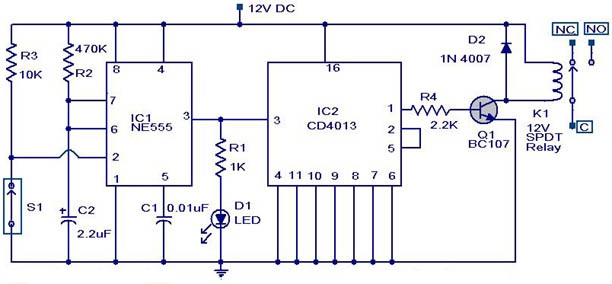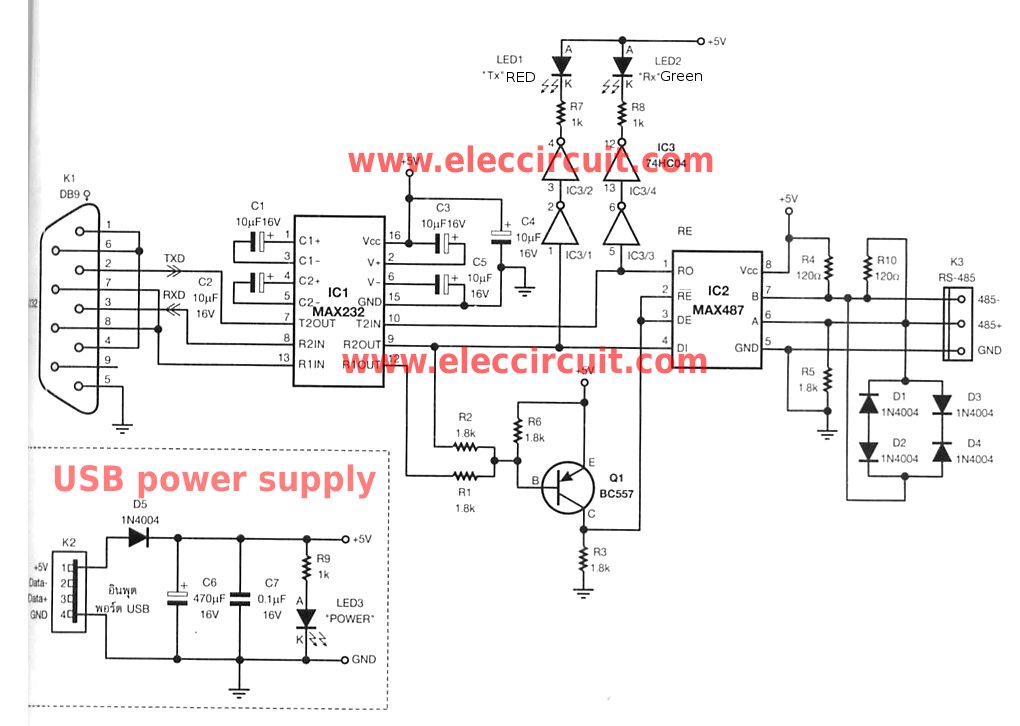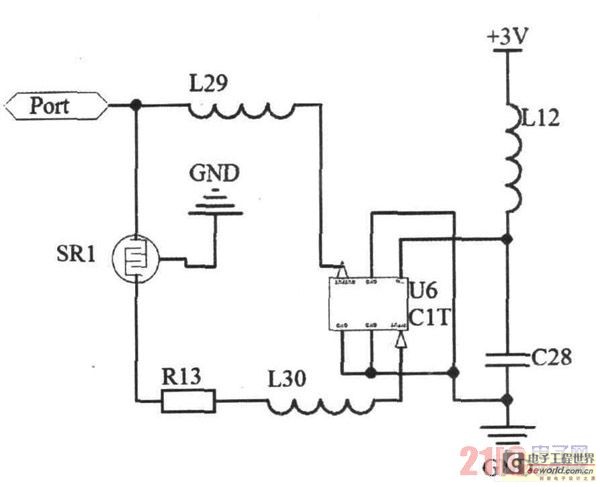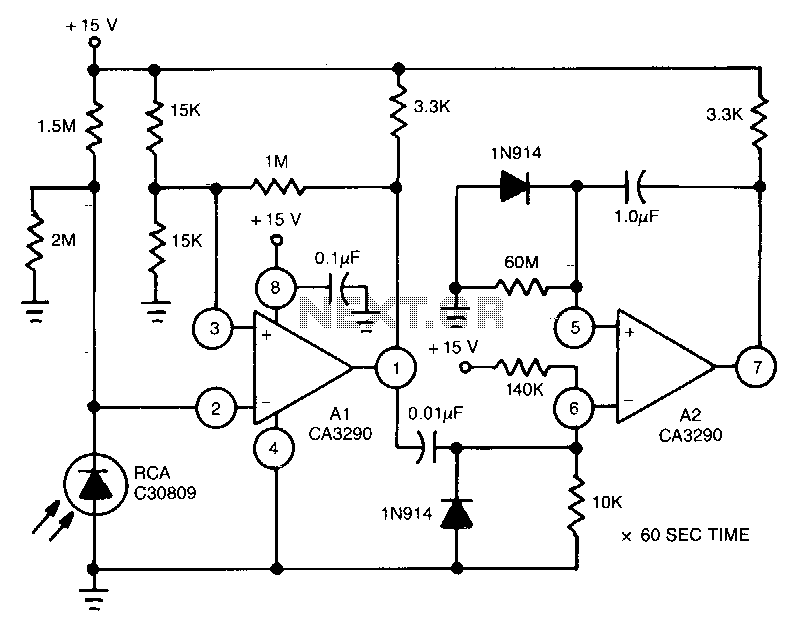
Baxendall tone control circuit
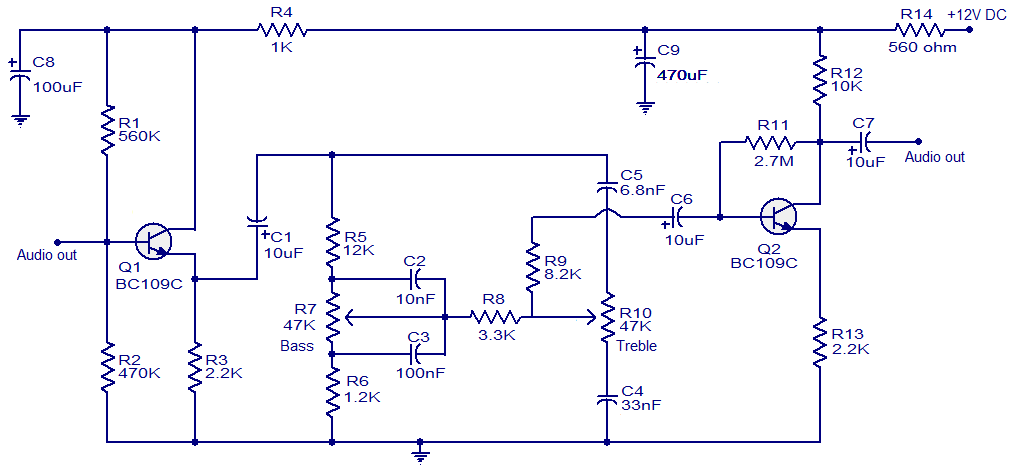
This simple tone control circuit is designed based on the renowned Baxendall tone control circuitry. The circuit can provide a maximum cut or boost of approximately 12 dB at both 10 kHz (treble) and 50 Hz (bass). Additionally, both bass and treble can be adjusted independently. Transistor Q1 (BC109) and its associated components (R1, R2, and R3) form an emitter follower, which serves as the input stage. The voltage gain of this input stage is about 1, with an input impedance of approximately 225 kΩ. The output of the input stage is coupled to the passive Baxendall circuitry via capacitor C1. POT R7 is utilized to adjust the bass, while POT R10 is used for treble adjustment. Transistor Q2, along with its associated components (R11, R12, and R13), constitutes the final output stage, providing an overall voltage gain of three to the system.
The tone control circuit based on the Baxendall design utilizes a combination of passive and active components to achieve effective audio signal manipulation. The circuit begins with the input stage, where the BC109 transistor (Q1) operates as an emitter follower. This configuration is advantageous as it offers a high input impedance, allowing it to interface seamlessly with various audio sources without loading them down. The emitter follower arrangement ensures that the input signal is buffered, resulting in minimal distortion and maintaining the integrity of the audio signal.
The passive Baxendall tone control network is integrated following the input stage, utilizing capacitors and resistors to shape the frequency response. The use of capacitor C1 serves to couple the output from the emitter follower to the tone control circuitry, blocking any DC offset while allowing AC audio signals to pass. The independent adjustment of bass and treble through potentiometers R7 and R10 provides users with flexibility in shaping the sound to their preference. The design allows for a substantial boost or cut in both frequency ranges, enhancing the listening experience across various audio playback scenarios.
The final output stage, formed by transistor Q2 and its associated resistors (R11, R12, and R13), amplifies the processed audio signal. This stage is crucial for increasing the signal level to a usable output for subsequent amplification stages or speakers. The overall voltage gain of three ensures that the audio signal is sufficiently amplified while preserving the tonal adjustments made in the earlier stages.
The circuit's design is compact and efficient, making it suitable for integration into various audio applications, including home audio systems, musical instruments, and other electronic devices requiring tone control. Proper layout and component selection will further enhance the performance and reliability of the circuit, ensuring high-quality audio output.This simple tone control circuit is designed based on the famous Baxendall tone control circuitry. The circuit given here can give a maximum cut or boost of around 12 dB at 10 KHz (treble) and 50Hz (bass). Also, both bass and treble can be independently adjusted. Transistor Q1 (BC109) and its associated components (R1, R2 and R3) form an emitter f ollower which is the input stage. The voltage gain of this input stage is around 1 and it has an input impedance of around 225K ohms. The output of the input stage is coupled to the passive Baxendall circuitry using the capacitor C1. POT R7 can be used to adjust the bass and POT R10 can be used to adjust the treble. Transistor Q2 and associated components (R11, R12 and R13) forms the final output stage which gives an overall voltage gain of three to the system. 🔗 External reference
The tone control circuit based on the Baxendall design utilizes a combination of passive and active components to achieve effective audio signal manipulation. The circuit begins with the input stage, where the BC109 transistor (Q1) operates as an emitter follower. This configuration is advantageous as it offers a high input impedance, allowing it to interface seamlessly with various audio sources without loading them down. The emitter follower arrangement ensures that the input signal is buffered, resulting in minimal distortion and maintaining the integrity of the audio signal.
The passive Baxendall tone control network is integrated following the input stage, utilizing capacitors and resistors to shape the frequency response. The use of capacitor C1 serves to couple the output from the emitter follower to the tone control circuitry, blocking any DC offset while allowing AC audio signals to pass. The independent adjustment of bass and treble through potentiometers R7 and R10 provides users with flexibility in shaping the sound to their preference. The design allows for a substantial boost or cut in both frequency ranges, enhancing the listening experience across various audio playback scenarios.
The final output stage, formed by transistor Q2 and its associated resistors (R11, R12, and R13), amplifies the processed audio signal. This stage is crucial for increasing the signal level to a usable output for subsequent amplification stages or speakers. The overall voltage gain of three ensures that the audio signal is sufficiently amplified while preserving the tonal adjustments made in the earlier stages.
The circuit's design is compact and efficient, making it suitable for integration into various audio applications, including home audio systems, musical instruments, and other electronic devices requiring tone control. Proper layout and component selection will further enhance the performance and reliability of the circuit, ensuring high-quality audio output.This simple tone control circuit is designed based on the famous Baxendall tone control circuitry. The circuit given here can give a maximum cut or boost of around 12 dB at 10 KHz (treble) and 50Hz (bass). Also, both bass and treble can be independently adjusted. Transistor Q1 (BC109) and its associated components (R1, R2 and R3) form an emitter f ollower which is the input stage. The voltage gain of this input stage is around 1 and it has an input impedance of around 225K ohms. The output of the input stage is coupled to the passive Baxendall circuitry using the capacitor C1. POT R7 can be used to adjust the bass and POT R10 can be used to adjust the treble. Transistor Q2 and associated components (R11, R12 and R13) forms the final output stage which gives an overall voltage gain of three to the system. 🔗 External reference
